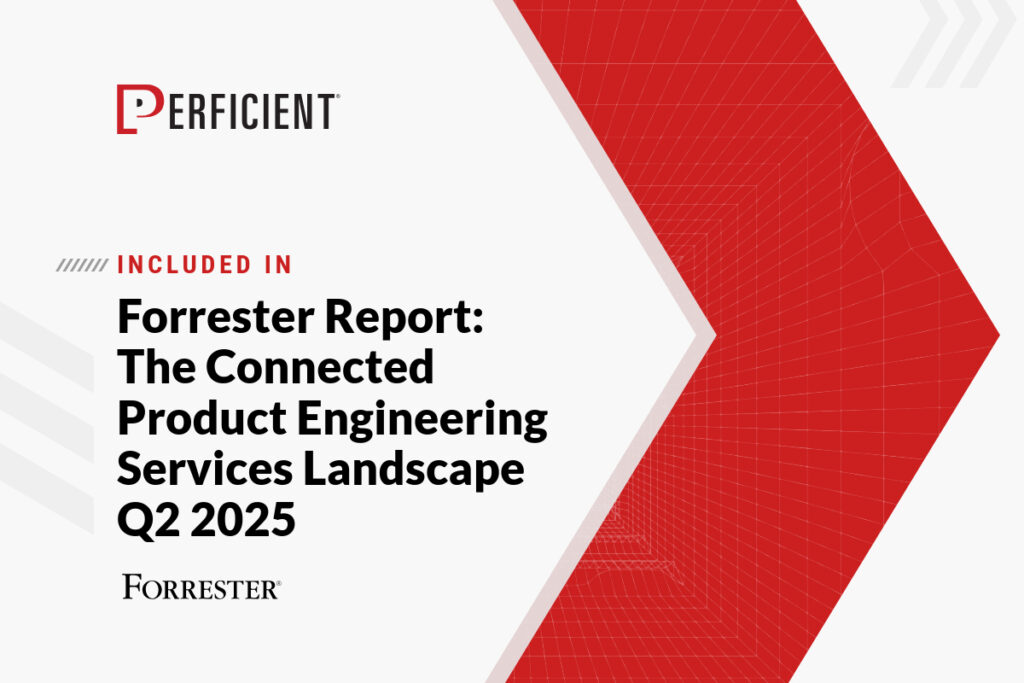We are thrilled to announce that Perficient has been recognized in Forrester’s recent report, “The Connected Product Engineering Services Landscape, Q2 2025.” Forrester defines connected product engineering services providers as:
“Firms that conceive, design, develop, launch, and scale new connected (or embodied) products that combine a physical product with digital applications to directly deliver new revenue for their clients.”
We believe this acknowledgment highlights our commitment to driving innovation and delivering exceptional value to our clients through connected product engineering services.
Access The Connected Product Engineering Services Landscape, Q2 2025 to find out more.
Driving Connected Product Innovation Across Key Industries
Whether it’s enabling a shift to product-as-a-service models, managing the ongoing support and monetization of field-deployed connected products, or improving workforce productivity through modern workplace technologies, we believe our strategic and management consulting expertise empowers organizations to navigate complexity and deliver meaningful outcomes. Notably, we’ve achieved success for clients in the life sciences, manufacturing, and utilities industries when it comes to connected product innovation. Our clients rely on us not only for engineering and implementation, but also for the high-value strategic work that drives connected product success.
What Are Connected Product Engineering Services?
From Perficient’s perspective, Connected Product Engineering Services are a comprehensive suite of offerings designed to create products that blend physical components with digital applications. These services cover the entire life cycle of product development, including:
Conception: Ideating new connected products that meet market needs and client requirements.
Design: Crafting designs that integrate both physical and digital elements to ensure seamless functionality and user experience.
Development: Building and programming the product, including hardware and software integration.
Launch: Bringing the product to market, including strategies for deployment and initial user adoption.
Scaling: Expanding the product’s reach and capabilities to grow user bases and evolving market demands.
The goal of connected product engineering services is to deliver products that not only function effectively but also generate new revenue streams for clients by leveraging the synergy between physical and digital technologies. Perficient’s expertise in this area runs deep and provides clients with improved data strategy, monetization, and user interfaces that ultimately instill customer trust and loyalty.
Common Disrupters and Challenges
With the results from Perficient’s own research, we have found that as the connected product landscape evolves, so do the challenges and disruptions organizations must navigate. One disruptor we’re seeing in the marketplace is the growing customer expectation for seamless interoperability between connected products. Namely, 50% of commercial users responded that their connected products integrated only “somewhat well” with their existing systems and infrastructure.
Buyers are increasingly making purchasing decisions based on how well new products integrate with their existing connected ecosystems. This shift is creating a strong push for increased collaboration and partnerships between OEMs to enable cross-product connectivity, such as linking garage door openers with vehicles or syncing household appliances with mobile devices.
Another challenge is overcoming negative customer sentiment toward connected features. Some consumers view these features as unnecessary luxuries or express concerns about privacy and data security. Only 19% of consumers feel aware of data collection practices. In industrial settings like manufacturing and supply chain, connected products are sometimes perceived as intrusive or overly surveillance-focused.
Additionally, there’s often a gap in user education. Many OEMs struggle to implement the right structures for ongoing support and training, making it difficult for customers to fully understand and leverage all available product features. Addressing these concerns through thoughtful design, transparent data practices, and strong customer enablement programs is essential for long-term success in the connected product space.
Perficient’s Approach to Connected Product Engineering
At Perficient, we take a comprehensive, end-to-end approach to connected product delivery, combining strategy, engineering, prototyping, and testing to bring innovative ideas to life. Especially when it comes to connected products, we understand that it starts with a strong data foundation. That’s why we prioritize helping clients define a robust data strategy from the start.
When the foundation is solid, identifying how to utilize that data and create new revenue streams is the next step. Subscription models are becoming a key driver of connected product monetization, and we guide clients in building scalable ecosystems that support recurring revenue. Additionally, we recognize that customer experience is a critical differentiator, often enabled through companion apps that provide seamless access to product features and functionality. These strategic considerations—data, subscriptions, and experience—are essential components of a successful connected product strategy, and they remain central to how Perficient delivers value to our clients.
Real and actionable insights drive our strategy. We’ve based our approach for connected product manufacturers on our own research – a study on the sentiments of consumers, commercial users, and manufacturers of connected products – which you can explore here.
Learn more about our manufacturing industry expertise.
Source: Read MoreÂ
